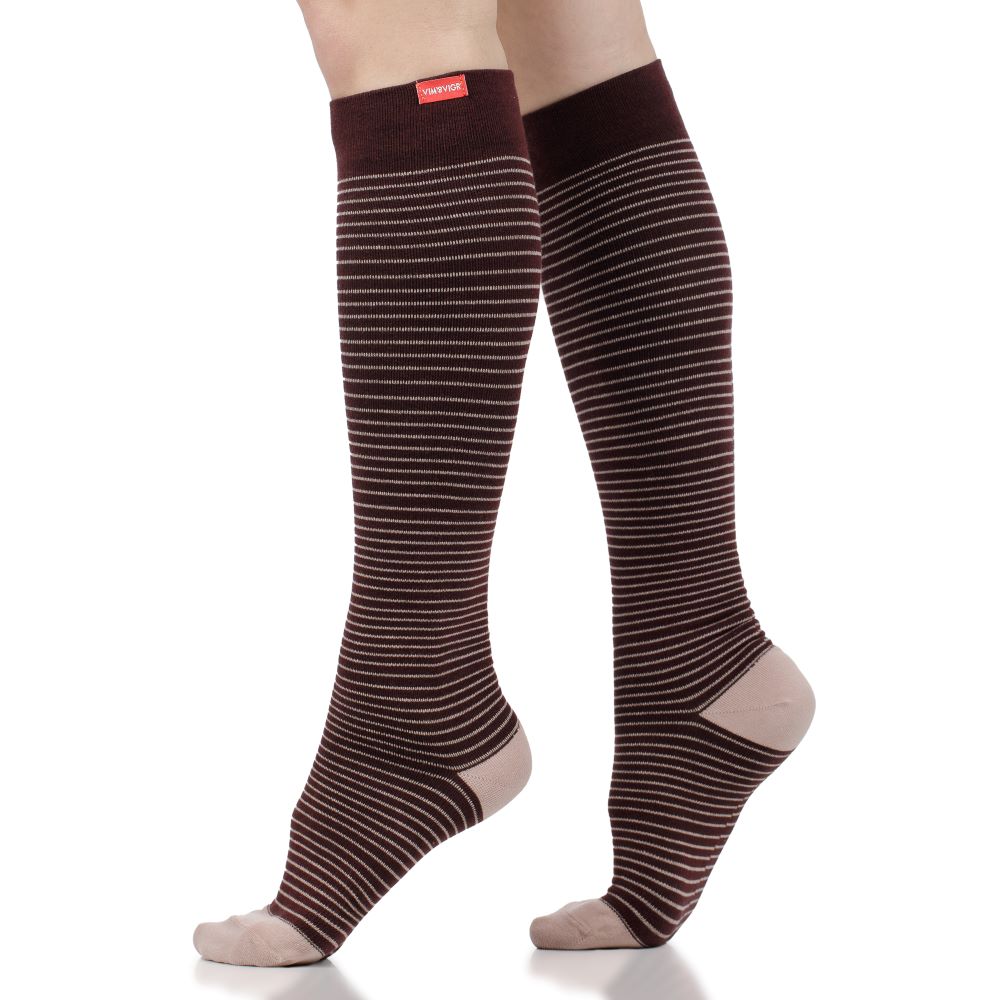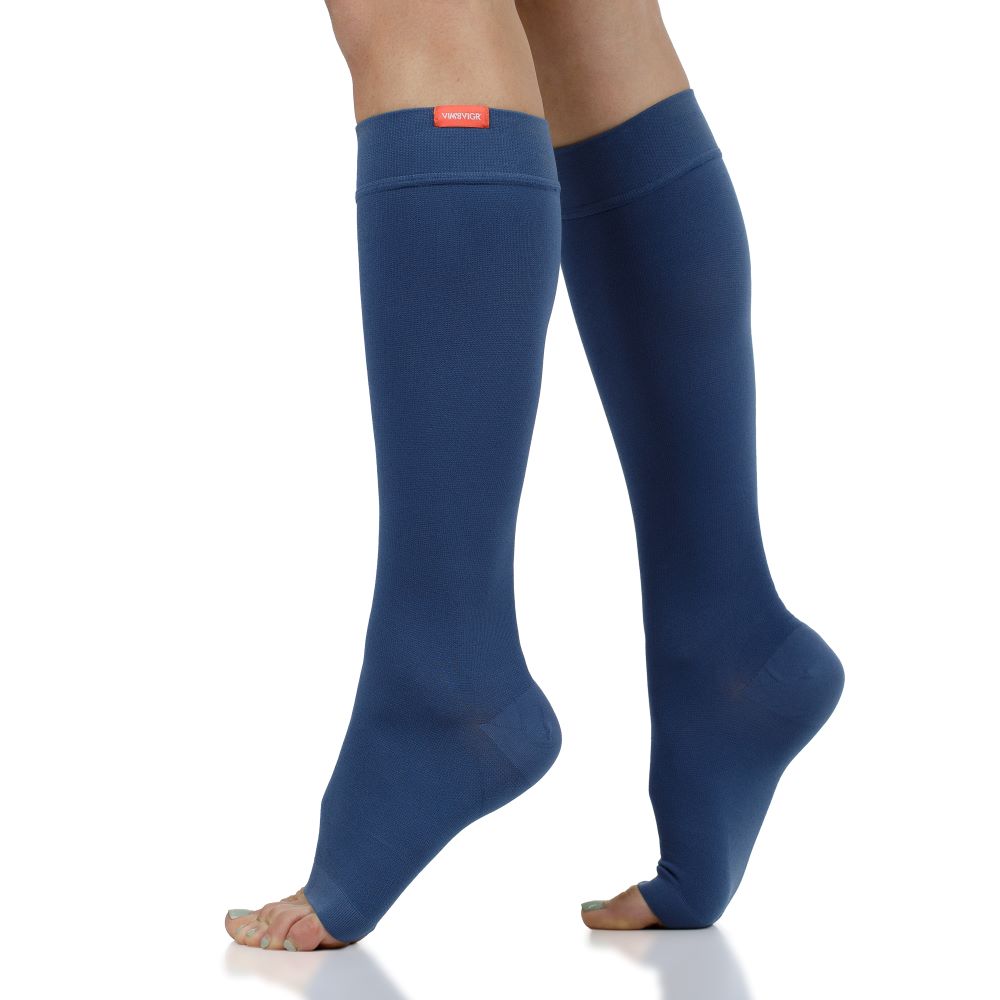Wearing Compression Socks for Tarsal Tunnel Pain Relief
Foot pain can take many forms, from on-the-spot injuries to longer-term conditions, such as trapped nerves or soreness caused by weak arches, among others. Tarsal tunnel syndrome is one of these types of pain, brought on by entrapment of the posterior tibial nerve.
What options do you have to relieve tarsal tunnel pain and how can compression socks contribute to alleviating some of the symptoms? Thanks to their role in reducing inflammation, swelling, and soreness, compression socks can make an important difference to those suffering from tarsal tunnel syndrome.
Read on to find out how to use compression socks for tarsal tunnel pain relief.
Understanding Tarsal Tunnel Syndrome and How Compression Socks Can Help
To understand the benefits of compression socks for tarsal tunnel syndrome, it’s important to first understand the condition. The tarsal tunnel is located on the inside of the ankle. It is made up of the ankle bones and the band of ligaments that stretches across the foot. It’s an area of crucial importance for foot flexibility and health, because a large number of blood vessels, nerves, and tendons all travel through the tarsal tunnel.
When the posterior tibial nerve - which also travels through the tarsal tunnel - becomes compressed, this causes tarsal tunnel syndrome (TTS). It manifests itself through pain, tingling, or numbness in the foot.
While TTS is a pretty rare occurrence, it can be caused by some situations where compression socks can be of help. These include:
- Flat feet or fallen arches;
- Swelling from an ankle sprain;
- Diseases like arthritis or diabetes, which can lead to feet and ankles swelling or to nerve compression;
- Varicose veins, ganglion cysts, swollen tendons, or bone spurs.
For many people, the symptoms are similar to plantar fasciitis, but these are two different conditions. If suffering from plantar fasciitis, you will feel pain on the bottom of the heel and in the arch of the foot. With TTS, the pain is located on the inside of the heel, just below the ankle, and it’s accompanied by stinging, burning, or tingling sensations.

Compression socks can help with symptoms of TTS through boosting blood flow and applying a gentle massage to the feet and ankles. They’ve been shown to reduce pain and inflammation in the lower legs, while the increase in localized blood flow helps drive down swelling and burning sensations. Moreover, compression socks can be used to treat conditions like diabetic neuropathy, varicose veins, flat feet, or ankle sprains, which can be the root cause of TTS - thus, reducing the risk of developing it.
The Science Behind Compression Socks for Tarsal Tunnel Syndrome
So, how do compression socks work to relieve the symptoms of tarsal tunnel syndrome? They have multiple applications, from symptom relief to helping to prevent TTS from setting in.
Graduated compression socks apply gentle pressure to the lower limbs, tighter towards the ankles and feet and gradually releasing towards the knees. The result of this graduated pressure is that blood flow is pushed upwards towards the heart. This reduces the risk of blood pooling in the lower legs, causing swelling and discomfort.
It also boosts peripheral circulation overall, and this is why compression socks can help with TTS. Increased blood circulation helps relieve pain, tingling, numbness, and burning sensations in the feet. Through better blood flow, patients can also experience less inflammation and reduce ankle and foot swelling. Finally, a healthy circulatory system is responsible for transporting oxygen and nutrients in the entire body. This also means promoting healing after an injury.
From a prevention perspective, compression socks worn by athletes and active people can relieve some of the pressure on the foot caused by flat feet or weak arches. They also actively prevent swelling in the foot and ankle area, which can lead to compressing the posterior tibial nerve. Finally, compression socks have long been used to prevent and treat blood vessel conditions like varicose veins - again, possibly helping to prevent TTS.

Benefits of Compression Socks for Tarsal Tunnel Syndrome
If you suffer from tarsal tunnel syndrome, you will experience pain, numbness, and tingling or burning in the foot. You may also be experiencing inflammation and swelling from an injury, such as ankle sprains. Or you could be returning to activity after an injury or suffering from TTS and have concerns around the stability of your feet and ankles. Compression socks are able to address all these scenarios.
Relieve Pain, Numbness, and Burning
The increase in blood flow stimulated by wearing compression socks is instrumental in reducing numbness, burning, tingling, or localized pain. This is why compression socks are often prescribed to patients that are bed-ridden post-surgery and who need a boost in blood flow to the periphery (to prevent feet going numb or swelling).
Moreover, compression socks apply a gentle massage through the feet and legs. This is pleasant and relaxing for sore feet, adding to pain relief and refreshing the limbs.
Reduced Inflammation and Swelling
Delivering continuous blood flow to the extremities helps bring down inflammation from exercise or injury. Moreover, compression socks combine gentle massage with increased blood flow to reduce swelling - further reducing the risk of developing TTS or helping manage its symptoms.
Improved Blood Flow to Promote Healing
Continuous, healthy circulation is the cornerstone of any well-functioning organism. However, certain conditions lead to the blood vessels becoming clogged or constricted, making this a challenge. Similarly, issues like swelling and blood pooling in the lower legs can make life harder for those trying to recover from a foot or ankle injury.
Compression socks act on the factors that reduce healthy blood flow. In return, oxygen and nutrients can be transported to the areas that are recovering and speed up the return to full health. They have also been linked to reduced recovery times between athletic efforts, further proving that the boost in blood flow they provide is effective and beneficial.

Foot and Ankle Support
While there are stronger, more structured support systems for medical conditions such as flat feet or for recovering joints (e.g., sprained ankles), compression socks can enhance that or offer a preliminary level of support to the feet and ankles. Their tight grip is reassuring and helps prevent further sprains for athletes who are returning from injury. Moreover, the support that compression socks provide to the lower legs also reduces the impact of micro vibrations through the muscles (particularly relevant, among others, for road runners who repeatedly land on a hard surface).
In the case of TTS, the support through the arch of the foot can relieve pain and discomfort, while ankle support from compression socks helps with recovery from sprains and strain - reducing the risk of tarsal tunnel pain.
Choosing The Best Compression Socks for Tarsal Tunnel Syndrome
To get the full benefits of compression socks, you need to ensure they fit you correctly. Compression socks apply pressure to the limbs and need to be tight enough to stimulate blood flow, but if they’re too tight, they’ll actually achieve the opposite result and cut off your circulation. And, of course, if they’re too loose, they’ll just be a nuisance, rolling down the legs and not providing the support and pressure needed. The solution is to follow a sizing guide, starting with measuring the circumference of your calf muscles.
Once you’ve received your first pair of compression socks, put them on carefully, ensuring that you don’t cause any bunching or folding in the material. You should also avoid pulling them unnecessarily. We have prepared a clear guide on how to put them on here.
Additionally, not all compression socks are as tight as each other. In fact, the level of pressure they apply to the limbs is measured in mmHg and generally categorizes these garments in three types:
- Moderate compression (15-20 mmHg) - suitable for everyday wear and casual use, for recovery from exercise, or as a preventative measure to reduce the risk of swelling, inflammation, plantar fasciitis or tarsal tunnel syndrome;
- Moderate to firm compression (20-30 mmHg) - tighter socks, usually prescribed to patients recovering from surgery and with reduced mobility to avoid swelling, blood clots, or discomfort; also suitable for those suffering from varicose veins, edema, or for pregnant women trying to reduce their discomfort; possibly useful for TTS sufferers;
- Firm compression (30-40 mmHg) - prescription compression socks that can only be purchased with doctor’s prescription; these are used to treat particular health conditions (like deep vein thrombosis and lymphedema) or injuries (which can include the tarsal tunnel syndrome).
Finally, a consideration for compression socks for tarsal tunnel syndrome is the fabric they’re made of. For everyday wear and the most versatility, cotton remains an excellent choice. However, if you’re looking for running compression socks that are sleeker and thinner, you may want to opt for nylon. And, for unbeatable moisture wicking and temperature regulation, merino wool is perfect no matter the season.

When and How to Wear Compression Socks for Tarsal Tunnel Syndrome
Compression socks impact people differently, depending on fitness levels, medical condition, and even environmental conditions. You may find that wearing them immediately relieves pain or irritation, but there are also benefits from wearing them for longer periods of time to prevent swelling or to relax after efforts or a long day on your feet.
To prevent the onset of tarsal tunnel syndrome, you can wear your compression socks ahead of or during long walks, especially if you have flat feet. You can also use compression socks as a warm-up tool, since the enhanced blood flow to the feet and calf muscles help prepare these areas for exercise or for efforts such as long walks or standing for a long time.
Compression garments are known for their soothing properties and as recovery tools first and foremost. When you suffer from sore, burning, or tingling feet from TTS, or when you notice swelling that threatens to lead to nerve entrapment leading to TTS, you can use compression socks as one of your recovery tools. If you’re unfamiliar with the feeling of compression, we suggest starting with a few hours on your first wear, and gradually increase from there.
Complementary Strategies for Tarsal Tunnel Syndrome
When you have sore, swollen feet from tarsal tunnel syndrome, here are a few more ways to get relief and strengthen your feet so you can reduce the likelihood of TTS flare-ups in the future.
Rest
In the first instance, a quick first step is to simply rest. Take weight off the affected foot, as preventing direct pressure on the tarsal tunnel will reduce the pain and tingling or burning feelings.
Ice
For the feeling of burning, sore feet, ice is sometimes effective in the short term. It will also help reduce the inflammation while you rest. The combination of these two actions, followed by wearing compression socks, is a good remedy for injuries like sprains and strains, and should also help make you feel better when you’re suffering from TTS.
Physical Therapy
Increasing muscular strength in the feet can be really beneficial for people suffering from TTS, especially when the syndrome is caused by flat feet or weak arches. Generally, better foot strength can contribute to improved stability and less of a risk of foot and ankle injuries, too.
We recommend looking into physical therapy exercises to develop balance and foot strength, along with stretching. Some simple stretches and rolls (where you use a massage ball to roll the foot on) can release tension in the arch and relieve some pain and inflammation. A physiotherapist will be able to advise on more options suited to you personally.



















Leave a comment